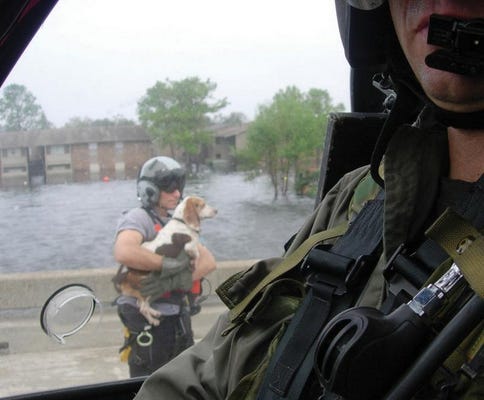source GAIA package: Sx_MilitaryTimes_M6201310308290030_5675.zip Origin key: Sx_MilitaryTimes_M6201310308290030 imported at Fri Jan 8 18:18:11 2016
 Nowadays, 13-year-old Katrina the beagle sleeps most days on a comfortable carpet in her Orlando, Fla., home, spending spare time time getting treats and hugs as the mascot of the 920th Rescue Wing, Patrick Air Force Base.
Nowadays, 13-year-old Katrina the beagle sleeps most days on a comfortable carpet in her Orlando, Fla., home, spending spare time time getting treats and hugs as the mascot of the 920th Rescue Wing, Patrick Air Force Base.
But eight years ago today, the small dog faced the same terror as other New Orleans residents trapped by flood waters pouring forth after the city's protective levees were breached during Hurricane Katrina.
Within a day of the storm making landfall in Louisiana, members of the 920th, including the 301st Rescue Squadron, were on scene, plucking the stranded to safety.
The 301st's Maj. Mike Brasher, co-pilot Robert Haston, now a lieutenant colonel, and the rest of an HH-60 Pave Hawk crew arrived in the Crescent City on Aug. 30. After flying for 13 hours and a brief rest, they were back on the job Sept. 1, when they took notice of an unusual sight: While conducting evacuations on the Interstate 10 overpass east of the city, a dog would run out to the helicopter to greet them.
"We'd land and she'd run up, tail wagging, this big smile on her face," Brasher remembered. "She'd just run into this 60-mile-an-hour rotor wash like it was no big deal."
When Senior Master Sgt. Pete Callina, one of the crew's pararescue jumpers, debarked, the beagle would join him and herd evacuees toward the helicopter.
The crew began referring to her as Barney the Beagle and looked forward to seeing her. On one of their later rescues, a man trying to get onto the helicopter kicked at the dog — something the crew was not very happy about.
"The PJ told the man if he kicked at the dog one more time, we, including Barney, would be getting back on the helicopter and not come back. Immediately, three ladies started hitting this man and told him he had better stop kicking the dog," Brasher told Arizona Humane Society officials shortly after the storm.
On the last sortie at the overpass, it became obvious the dog didn't belong to anyone, so the crew decided to take her with them. After an aerial refueling over Lake Pontchartrain, the airmen handed her over to ground personnel.
But the dog's story didn't end there. Brasher's crew continued flying search and rescue operations until mid-September, but they never forgot the smiling dog. After the 920th packed up and went home, Brasher continued looking for her on TV news stories about storm animal rescues and on the Internet.
By late September, Brasher's wife, Melanie, started poring through more than 900 photos of storm-stranded beagles on petfinder.com. The effort proved successful: Melanie located the dog at a shelter in Phoenix.
By now referred to as Katrina, the beagle had gone from Brasher's helicopter to an emergency shelter, to a local New Orleans animal hospital and a temporary shelter in Gonzalez, La. She then traveled on an Air National Guard KC-135 tanker to Phoenix, where she was treated for heartworm and other illnesses.
But Katrina's travels weren't over. More than two months after her first flight on a storm-battered helicopter, Katrina was placed on a Continental airliner to Orlando.
More than 6,000 animals were rescued after Hurricane Katrina struck Louisiana and Mississippi; an estimated 600,000 died or were left homeless.
The massive abandonment and loss of animals — many who were left behind because evacuation personnel refused to accommodate pets and emergency shelters were not allowed to house animals — prompted Congress to pass the Pets Evacuation and Transportation Standards Act, requiring states seeking Federal Emergency Management Agency help after a disaster to have a plan in place for pets and service animals.
The official death toll for humans from Katrina stands at 1,833, according to the National Oceanographic and Atmospheric Administration. The 920th Air Wing saved 1,043 people; during the course of Brasher's 13-hour rescue marathon, his crew picked up 184 people, six dogs and two cats.
After Katrina arrived at the Brashers' home, the Arizona Humane Society located her owners, but they relinquished ownership.
Nearing the eighth anniversary of Hurricane Katrina, Brasher proudly shows off the photos he keeps on his iPad of his crew members, those they rescued in the historic storm and Katrina.
The story of his intrepid dog and her exuberance on that trash-strewn, rain-soaked highway overpass in New Orleans has gotten him through some of his darker days, during harrowing and heart-wrenching rescues of wounded service members, children and civilians in Afghanistan.
"I get bummed when I think she's already 13. She, as well as the crew that rescued her, are all a little more gray these days," he said.




